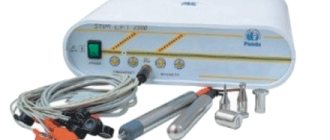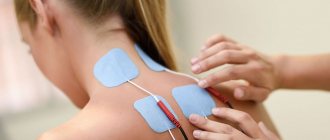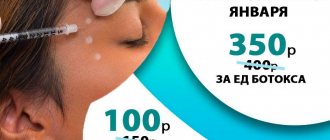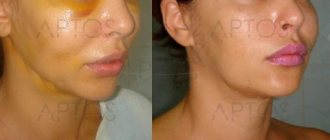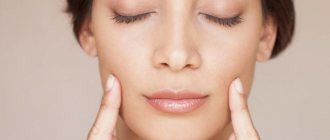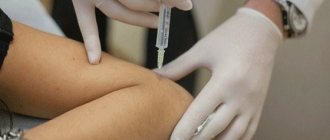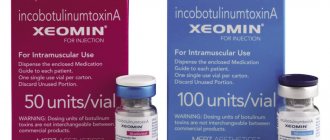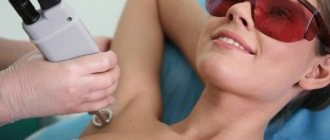There are many different methods in the world that provide hair restoration. Most of them are physical therapy (physical impact on the scalp). Let's look at some of its techniques.
A procedure such as iontophoresis affects the deep layers of the scalp with galvanic currents. As a result, subcutaneous blood circulation becomes faster, nutrients penetrate deeper into the skin cells, and the process of strengthening and rapid hair growth occurs.
In order to enhance the activity of scalp tissues, a procedure such as electrical stimulation is used. Pulsed currents affect blood vessels and metabolism, the volume of fat cells becomes smaller, and hormonal levels improve.
What is iontophoresis?
Iontophoresis
is the penetration of an ionized substance through intact skin under the influence of direct current. Iontophoresis is a simple, economical and effective method of treating hyperhidrosis and is recommended to patients before more invasive treatments are prescribed.
Iontophoresis is used for palmar, foot and axillary hyperhidrosis.
Cautions
The use of iontophoresis is not recommended during pregnancy, in the presence of cardiac pacemakers, with existing metal implants (for example, artificial joints), with cardiac pathology, epilepsy. During the procedure, you should remove all jewelry from your arms or legs. If dry skin develops during use, it is recommended to use moisturizers. Damaged skin, cuts, injured nails - must be lubricated with Vaseline or other protective cream to prevent skin irritation. To alleviate developed skin irritation, you can use 1% hydrocortisone cream.
Many patients are concerned about the risk of possible electrical shock during the procedure. It should be noted that the level of electrical current during the procedure is minimal and cannot cause harm. Some pain is possible, but with proper use of iontophoresis it can be avoided or minimized.
The use of iontophoresis in the armpit area is somewhat difficult, since the skin of the axillary area is highly sensitive to iontophoresis, and it is technically difficult to provide adequate treatment in this area. For the use of iontophoresis in the armpit area, there are special pad devices. A number of patients manage to achieve positive results when using them, although this occurs much less frequently than when treating excessive sweating of the palms and feet. Iontophoresis for axillary hyperhidrosis is often used as a complement to other methods (the use of medical antiperspirants or botulinum toxin injections) to achieve a greater dryness effect.
The success of using iontophoresis is achieved after some training in its use, so it is very important to discuss the possibility of using iontophoresis with your doctor.
Prevention
The main rule of prevention is hygiene. Remember that sweat has no odor. An unpleasant odor is the result of the proliferation of bacteria that live in the human body. Most people hide this smell with the help of deodorants, which perform two functions at the same time: they solve the problem of repulsive odor and have an antibacterial effect on the skin.
Doctors Telos Beauty prof. We have compiled a list of recommendations that will help reduce sweating:
- Even if it's very hot outside, try not to drink a lot of fluids. The secret is simple: the more water you drink, the more sweat your body produces.
- At any time of the year, dress according to the weather outside: your body temperature should not rise because you are wearing too warm clothes.
- Take care of yourself with special cosmetics and antiperspirants.
- If you often feel stressed, visit a therapist and try to understand the reasons for your condition. The phrase “all diseases come from nerves” was not coined by people by chance. The worries and fears that we experience provoke increased sweating.
- Choose clothes made from natural fabrics - cotton, linen, wool.
- A visit to a Russian bath will have a general healing effect.
- If your weight is above normal (in relation to your height), visit a nutritionist and work with him to develop a weight loss program.
- Do not eat overly hot or spicy foods. Also reduce your consumption of honey and raspberries.
- Shave your armpit hair.
Telos Beauty specialists prof. will help you choose the right way to combat hyperhidrosis. Call the clinic and make an appointment for a consultation. The doctor will conduct an examination and propose a treatment regimen that is guaranteed to cope with increased sweating.
History of the method
In 1936 Ichihashi
used various solutions of atropine, histamine and formaldehyde in combination with iontophoresis and demonstrated that palm sweating could be reduced.
Unfortunately, this went largely unnoticed until 1952, when Bowman and Grunewald Lentze
r reported the effectiveness of iontophoresis in the treatment of palmar and plantar hyperhidrosis in 113 patients. They concluded that it was not necessary to add ionizing substances to water to obtain a therapeutic effect. Using regular tap water turned out to be quite sufficient. But this achievement remained unnoticed until Levit published two reports in 1968 and 1980 on the treatment of hyperhidrosis with iontophoresis using tap water.
Diagnostics
Basic diagnostic methods:
- Examination, history taking and examination.
- Test with starch and iodine.
- Tests to identify factors influencing excessive sweating.
As a rule, an examination is sufficient to make a diagnosis, but sometimes doctors resort to an iodine-starch test. The problem area is wiped with an iodine solution, and when it dries, starch is sprinkled on top. Darkened areas indicate excessive sweating.
The tests mentioned in the third point are carried out in laboratory conditions. To do this, the patient donates blood and other biological materials. The results of laboratory tests not only confirm the diagnosis, but also make it possible to detect the cause of the disease: improper functioning of the thyroid gland, blood poisoning, diabetes mellitus.
How does iontophoresis work? Why does the sweat glands “turn off” and how long does the effect last?
There are two main theories
, explaining the effect of iontophoresis on human sweat glands. They are based on the study of experimentally induced miliaria rubra (milliaria - red millet-like rash) on random areas of the skin (on the feet and palms).
The first theory can be called the electric gradient theory
. Sulzberger and Herrmann observed decreased sweating in volunteers with iontophoresis-induced miliaria. They hypothesized that the passage of sweat through the sweat ducts is driven by an electrical gradient. It has been hypothesized that iontophoresis affects this gradient, leading to disruption of the mechanism of sweat passage through the sweat tubules. But there are several questions: if this is true, then why does iontophoresis block hyperhidrosis of the palms and feet for several weeks? And is it possible that iontophoresis disrupts the electrical conductivity of the sweat ducts for such a long time?
The second theory can be conventionally called the “traffic jam theory”
. A number of authors, studying miliaria rubra caused by iontophoresis, discovered the formation of Schiff-positive, diastase-resistant material (plugs) in the lumen of the eccrine sweat glands. The presence of these plugs, in their opinion, causes the development of inflammation in miliaria rubra. Could these plugs be the cause of suppression of palmar and plantar hyperhidrosis? This theory is supported by reports from Gordon and Maibach and Grice et al. in which the effect of iontophoresis was reversed by peeling cellophane tape from skin with eccrine sweat glands rendered euhydrotic by iontophoresis. This release appears to relieve sweat gland obstruction. It should be noted that iontophoresis in the successful treatment of palmar and plantar hyperhidrosis does not lead to the formation of miliaria, and Hill et al were unable to demonstrate the presence of “plugs” or other morphological changes in the skin of successfully treated patients, which argues against this theory.
Thus, the exact mechanism of action of iontophoresis is still unclear.
We share with you the TOP 5 devices for facial iontophoresis at home:
LL NANO SKIN
An innovative Japanese device for comprehensive rejuvenation and intensive face lifting. The device is based on 6 functional rejuvenation technologies, which include more than 20 skin care procedures.
Technologies:
- RF lifting (radio wave lifting)
- EMS (electrical muscle stimulation)
- ENI (electroporation);
- ION (iontophoresis)
- Photodynamic LED therapy
- COOL-lifting
Results after use: effective face lift and rejuvenation, wrinkle correction, elastic healthy skin, treatment of acne and post-acne, scars and scars, pigmentation, smooth relief and fresh complexion, disappearance of swelling and dark circles under the eyes.
The set of procedures will take you 10-15 minutes.
BUY LIFTING DEVICE LL NANOSKIN
LL YAMAN
The younger brother of LL Nano Skin. A multifunctional Japanese device for lifting and comprehensive skin care, which combines all the most effective technologies for lifting, cleansing, moisturizing and rejuvenating the skin.
Technologies:
- RF lifting – smoothing out wrinkles
- EMS – toning facial muscles
- Iontophoresis – skin cleansing/nourishing
- LED therapy: red and blue light
- Cooling – cold compress
Results after use: pronounced, clear oval of the face, correction of deep and fine wrinkles, increased tone of the skin and muscles of the face, normalization of the sebaceous glands, treatment of acne and post-acne. Elastic healthy skin.
The set of procedures will take you 10 minutes.
BUY A YAMAN LIFTING DEVICE
LL MISMON
The innovative device for intensive lifting LL Mismon provides comprehensive facial skin rejuvenation at home. Equipped with 8 advanced cosmetology technologies.
Technologies:
- RF lifting
- EMS lifting (electrical muscle stimulation)
- ION Cleaning
- ION Moisturizing (nutrition)
- Eye Care (skin care around the eyes)
- Vibration (micromassage)
- LED (photodynamic therapy)
- COOL (skin cooling after procedures)
Results after use: smoothing wrinkles, tightening and modeling the ideal oval, lightening age spots and moles, lymphatic drainage, reducing inflammatory processes, comprehensive visible skin rejuvenation.
The time of one procedure is 16 minutes. Visible tightening and rejuvenation effect after 1 procedure.
BUY MISMON LIFTING DEVICE
LL KANDO
The Japanese LL Kando device is our exclusive device for comprehensive home facial skin rejuvenation. The device combines 6 advanced cosmetological technologies for comprehensive face lifting. A session with LL Kando consists of 6 sequential procedures:
- Skin cleansing + vibration massage
- Caring for the skin around the eyes
- Nutrition
- EMS stimulation
- RF+LED therapy
- COOL-lifting
Technologies:
- RF lifting (radio wave skin rejuvenation)
- EMS lifting (electrical muscle stimulation)
- Photodynamic LED therapy: red and blue light
- Eye-Care (care for the skin around the eyes) based on RF technology
- Iontophoresis (cleansing and moisturizing the skin)
- Vibromassage: improves blood circulation and lymph outflow, which improves metabolism and stimulates cell regeneration
- COOL-lifting (skin cooling after procedures)
The result will not be long in coming. After the first procedure, the skin will noticeably transform: it will become smoother, firmer, more hydrated, and acquire a healthy color.
The time of the complex of procedures is 17 minutes.
BUY LIFTING DEVICE LL KANDO
Bibliography
Ichihashi T: Effect of drugs on sweat glands by cataphoresis, and an effective method for suppression of local sweating. Observation on the effect of diaphoretics and adiaphoretics. J Orient Med 1936; 25:101-102.
Bowman HD, Grunewald Lentzer EM: The treatment of hyperhidrosis of feet with constant current. Am J of Phys Med 1952; 31: 158-169.
Levit F: Simple device for the treatment of hyperhidrosis by iontophoresis. Arch Dermatol 1968; 98:505-507.
Levit F: Treatment of hyperhidrosis by tap water iontophoresis. Cutis 1980;26:192-194.
Sulzberger MB, Herrmann F: The clinical Significance of Disturbances in the Delivery of Sweat. Springfield, Ill, Charles C Thomas Publishers, 1954, pp 9-12.
Loewenthal L: Experimental miliaria: Iontophoresis with salt solutions. Arch Dermatol 1962; 86:455-460.
Shelley W, Horvath P, Weidman F et al: Experimental miliaria in man: Production of sweat retention anhidrosis and vesicles by means of iontophoresis. J Invest Dermatol 1969; 53: 436-439.
Dobson R, Lobitz W: Some histochemical observations on the human eccrine sweat glands: II. The pathogenesis of miliaria. Arch Dermatol 1957; 75:653-666.
Gordon B, Maibach H: Eccrine anhidrosis due to glutaraldehyde, formaldehyde, and iontophoresis. J Invest Dermatol 1969; 53:436-439.
Grice K, Sattar H, Baker H: Treatment of idiopathic hyperhidrosis with iontophoresis of tap water and poldine methosulphate. Br J Dermatol 1972; 86: 72-77.
Hill AC, Baker GF, Jansen GF: Mechanism of action of iontophoresis in the treatment of palmar hyperhidrosis. Cutis 1981; 28:69-72.
